"Vinsobres or sober wine, drink it soberly".. Monseigneur Joseph Marie de Suarès (Bishop of Vaison-La-Romaine) in1633
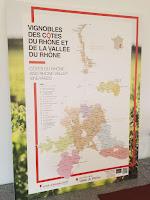 The Rhône Valley is a diverse and complex wine region that I've been slowly trying to comprehend. In 2023 I started with a Côtes du Rhône Online Wine Academy course in April and attended the Academy du Rhône Wine this month in Washington D.C. The Academy was hosted by Master Sommelier David Keck and showcased 18 wines from various appellations within the Rhône Valley all the while discussing the grapes and terrior within each region. The Rhône Valley is located in southeast France between Lyon and Marseille and is sub-divided into Northern and Southern regions. Southern Rhône is sandwiched between Provence to the east and Languedoc-Roussillon to the west and is known for its Grenache, Syrah, and Mourvèdre (GSM) blends. On the other hand, Syrah is the champion of the Northern Rhône with Marsanne, Roussanne and Viognier its white counterparts. Overall, the Rhône Valley accounts for 9% of all French vineyards and ranks 2nd by volume for all French AOC wine regions.
The Rhône Valley is a diverse and complex wine region that I've been slowly trying to comprehend. In 2023 I started with a Côtes du Rhône Online Wine Academy course in April and attended the Academy du Rhône Wine this month in Washington D.C. The Academy was hosted by Master Sommelier David Keck and showcased 18 wines from various appellations within the Rhône Valley all the while discussing the grapes and terrior within each region. The Rhône Valley is located in southeast France between Lyon and Marseille and is sub-divided into Northern and Southern regions. Southern Rhône is sandwiched between Provence to the east and Languedoc-Roussillon to the west and is known for its Grenache, Syrah, and Mourvèdre (GSM) blends. On the other hand, Syrah is the champion of the Northern Rhône with Marsanne, Roussanne and Viognier its white counterparts. Overall, the Rhône Valley accounts for 9% of all French vineyards and ranks 2nd by volume for all French AOC wine regions.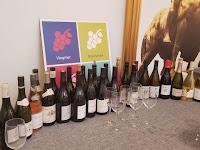 The Rhône Valley's wine history is quite fascinating and starts three hundred million years ago as the Massif Central clashed with the Alps creating the valley and then flooding from the Mediterranean populated the valley’s soils with four different types of rock: granite, sandy silica, limestone and clay. This created conditions for the Greeks & Romans to apply viticulture which continued through the Avignon Popes up to the 1930's when Baron Le Roy championed the creation of the Appellation d’Origine Contrôlée system. The Rhône Valley was granted AOC status in 1933. Read more of the Rhône Valley's entire history at the Vins Rhône website.
The Rhône Valley's wine history is quite fascinating and starts three hundred million years ago as the Massif Central clashed with the Alps creating the valley and then flooding from the Mediterranean populated the valley’s soils with four different types of rock: granite, sandy silica, limestone and clay. This created conditions for the Greeks & Romans to apply viticulture which continued through the Avignon Popes up to the 1930's when Baron Le Roy championed the creation of the Appellation d’Origine Contrôlée system. The Rhône Valley was granted AOC status in 1933. Read more of the Rhône Valley's entire history at the Vins Rhône website. 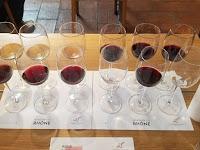 In brief, there are 34 different grape varieties planted in the Rhône Valley and red wines account for 76% of production, rosé 13%, and whites 11%. The diverse landscape consists of five major soil types: clay, stony, limestone, granitic, and sandy soils. Again see Vins Rhône for a more detailed presentation. There are 31 appellations grouped within two major areas: Côtes du Rhône AOCs and Rhône Valley AOCs. The Côtes du Rhône AOC accounts for 75% of the overall production in the Rhône Valley and itself consists of a hierarchy starting with the Côtes du Rhône Crus, Côtes du Rhône Villages with a geographic name, Côtes du Rhône Villages, and Côtes du Rhône. Red wine accounts for 86% of overall Côtes du Rhône production, rosé 8%, and whites 6%. The Rhône Valley AOCs are more prevalent in the Southern Rhône and are distributed in a wider area from the Rhone River.
In brief, there are 34 different grape varieties planted in the Rhône Valley and red wines account for 76% of production, rosé 13%, and whites 11%. The diverse landscape consists of five major soil types: clay, stony, limestone, granitic, and sandy soils. Again see Vins Rhône for a more detailed presentation. There are 31 appellations grouped within two major areas: Côtes du Rhône AOCs and Rhône Valley AOCs. The Côtes du Rhône AOC accounts for 75% of the overall production in the Rhône Valley and itself consists of a hierarchy starting with the Côtes du Rhône Crus, Côtes du Rhône Villages with a geographic name, Côtes du Rhône Villages, and Côtes du Rhône. Red wine accounts for 86% of overall Côtes du Rhône production, rosé 8%, and whites 6%. The Rhône Valley AOCs are more prevalent in the Southern Rhône and are distributed in a wider area from the Rhone River. 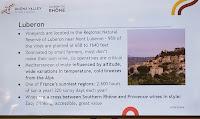 Whereas most of the 18 wines we sampled were from the Côtes du Rhône there were a handful from Rhône Valley AOCs with one I especially enjoyed, the M. Chapoutier La Ciboise Luberon 2022. This wine is a blend of Grenache Blanc, Roussanne, Ugni Blanc and Vermentino from the Luberon AOC. The vineyards for this appellation and high in elevation and surround the Luberon Natural Regional Park, part of UNESCO’s World Network of Biosphere Reserves. Luberon is dominated by small farmers and cooperatives and this region is one of France's sunniest with 320 sunny days each year. It also straddles Provence so the wines closely resemble that style in the sense of easy-drinking and value. This La Ciboise is a fresh and lively wine, yet creamy and structured, with noticeable citrus and stone fruit.
Whereas most of the 18 wines we sampled were from the Côtes du Rhône there were a handful from Rhône Valley AOCs with one I especially enjoyed, the M. Chapoutier La Ciboise Luberon 2022. This wine is a blend of Grenache Blanc, Roussanne, Ugni Blanc and Vermentino from the Luberon AOC. The vineyards for this appellation and high in elevation and surround the Luberon Natural Regional Park, part of UNESCO’s World Network of Biosphere Reserves. Luberon is dominated by small farmers and cooperatives and this region is one of France's sunniest with 320 sunny days each year. It also straddles Provence so the wines closely resemble that style in the sense of easy-drinking and value. This La Ciboise is a fresh and lively wine, yet creamy and structured, with noticeable citrus and stone fruit. 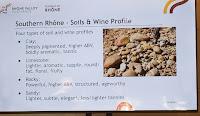 Turning to the Côtes du Rhône, I want to focus on two wines from the tasting starting with the Southern Rhône Chateau de Rouanne 2020 AOC Vinsobres. The Vinsobres Crus commune has a long history of viticulture and the name is derived from "Vinzobrio, the oldest recorded version of the village name, dating back to 1137; this in turn is thought to derive from the pre-Celtic Vintio, meaning height, and the Celtic suffix briga (mountain)". It is one of the most northernly southern communes and thus shares many notable northern characteristics such as exposure to the mistral winds and a stronger reliance on Syrah. The vineyards are at high elevations and the vines are planted in very stony, red to brown soils where their warmth allows the vines to ripen early. This wine is a GSM blend of 50% Grenache, 40% Syrah and 10% Mourvèdre where whole clusters were vinified and aged in concrete vats using native yeasts. This is an elegant and complex wine, with juicy dark fruit, black pepper and earth, and silky tannins. As the quote relates above, this is a sober (and serious) wine.
Turning to the Côtes du Rhône, I want to focus on two wines from the tasting starting with the Southern Rhône Chateau de Rouanne 2020 AOC Vinsobres. The Vinsobres Crus commune has a long history of viticulture and the name is derived from "Vinzobrio, the oldest recorded version of the village name, dating back to 1137; this in turn is thought to derive from the pre-Celtic Vintio, meaning height, and the Celtic suffix briga (mountain)". It is one of the most northernly southern communes and thus shares many notable northern characteristics such as exposure to the mistral winds and a stronger reliance on Syrah. The vineyards are at high elevations and the vines are planted in very stony, red to brown soils where their warmth allows the vines to ripen early. This wine is a GSM blend of 50% Grenache, 40% Syrah and 10% Mourvèdre where whole clusters were vinified and aged in concrete vats using native yeasts. This is an elegant and complex wine, with juicy dark fruit, black pepper and earth, and silky tannins. As the quote relates above, this is a sober (and serious) wine. 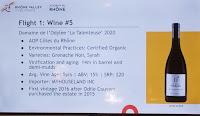 Returning to the beginning of the session, the first flight featured wines from the AOC Côtes du Rhône. The entire appellation stretches from Vienne to Avignon and includes 171 communes across six departments: Ardèche, Drôme, Gard, Loire, Rhône and Vaucluse), covering an area of around 30,000 hectares. The climate is Mediterranean, refreshed by the cleansing and cooling Mistral wind. Summers are hot and dry, with occasional violent storms. Rainfall is low, and snow is rare. One of my favorites of the initial flight was the Domaine de l'Odylée. La Talentuese 2020 -- a certified organic blend of Grenache and Syrah. The wine ages 14 months in oak barrels and demi-muids which contributes to a it's depth and complexity. There's a slight earthiness and herbaciousness on the nose followed by plums and raspberries and a spicy and firm finish.
Returning to the beginning of the session, the first flight featured wines from the AOC Côtes du Rhône. The entire appellation stretches from Vienne to Avignon and includes 171 communes across six departments: Ardèche, Drôme, Gard, Loire, Rhône and Vaucluse), covering an area of around 30,000 hectares. The climate is Mediterranean, refreshed by the cleansing and cooling Mistral wind. Summers are hot and dry, with occasional violent storms. Rainfall is low, and snow is rare. One of my favorites of the initial flight was the Domaine de l'Odylée. La Talentuese 2020 -- a certified organic blend of Grenache and Syrah. The wine ages 14 months in oak barrels and demi-muids which contributes to a it's depth and complexity. There's a slight earthiness and herbaciousness on the nose followed by plums and raspberries and a spicy and firm finish. Hopefully I will have more content to post n this tasting and further exploration of the Rhône Valley.
